Jason D. Burr
Graham W. Fiorani
Kimberly F. Leach
Rick H. Lin
Engineering 100
Section 103
University of Michigan
Date Submitted-December 13, 1999
Table Of Contents
1. Foreword
2. Summary
3. Ground-based Telescopes: The OverWhelmingly Large Telescope
3.1 The Mechanical Structure of the OWL
3.2 The Advantages of the OWL
4. X-Ray Telescopes: The Chandra X-Ray Telescope
4.1 The Mechanical Structure of the Chandra
4.2 The Advantages of Chandra
5. Space Telescopes: The Next Generation Space Telescope
5.1 The Goals of the NGST
5.2 The Advantages of the NGST
6. Critique of Astronomical Observation Systems
6.1 The OverWhelmingly Large Telescope
6.2 The Chandra X-Ray Telescope
6.3 The Next Generation Space Telescope
7. Next Generation Space Telescope Designs
7.1 Orbit
7.1.1 L2 Orbit
7.1.2 AU Orbit
7.2 Lockheed Martin Concept
7.2.1 Goals of the Lockheed Martin Concept
7.2.2 Advantages and Disadvantages of the Lockheed Martin Concept
7.3 TRW-Ball Aerospace Concept
7.3.1 Goals of the TRW-Ball Aerospace Concept
7.3.2 Advantages and Disadvantages of the TRW-Ball Aerospace Concept
7.4 GSFC Concept
7.4.1 Goals of the GSFC Concept
7.4.2 Advantages and Disadvantages of the GSFC Concept
8. Next Generation Space Telescope Instrumentation
8.1 Cameras
8.1.1 Camera Design Goals
8.1.2 Near-infrared Camera
8.1.3 Mid-infrared Camera
8.2 Spectrographs
8.2.1 Spectrograph Design Goals
8.2.2 Near-infrared Spectrograph
8.2.3 Mid-infrared Spectrograph
9. Next Generation Space Telescope Lightweight Optics
9.1 Lightweight Optics Requirements
9.2 Mirror Designs
9.2.1 Glass Membrane Mirror
9.2.2 Zerodur Mirror
9.2.3 Nickel Alloy Mirror
9.2.4 Silicon Carbide Mirror
10. Conclusions and Recommendations
Our group has researched various systems for the advancement of astronomical observation, in order to determine the most beneficial path for future advancement. We have analyzed and critiqued three alternative systems in the field, in order to select the best system, and then to provide an in-depth analysis of the chosen system. The purpose of this paper is to report our findings, and propose the best plan for developing the chosen system.
We have analyzed and compared three systems for astronomical observation: the OverWhelmingly Large Telescope, a ground-based system; the Chandra X-Ray Telescope, an X-Ray space telescope; and the Next Generation Space Telescope, a space based system. These systems are examined and then critiqued; our choice of best alternative is then presented in a technical analysis. We have chosen the Next Generation Space Telescope, and we conclude with our recommendation for the best course of advancing this system.
3. Ground-based Telescopes: The OverWhelmingly Large Telescope (OWL)
Although this has become the age of space-based technology, ground-based astronomical observation has not been overlooked. Many improvements are being considered in the ground-based field. One of the latest ground-based technologies under consideration is called the OverWhelmingly Large Telescope or simply the OWL. The purpose of the OWL will be to use traditional imaging to identify celestial bodies in greater detail. The OWL is currently under study at the European Southern Observatory (ESO). The optical engineers have finalized its blue prints. It is expected to cost around 900 million dollars; if it is funded, it could see its first technical light in 2012, become capable of limited observation in 2015, and be fully operational in 2018. (Schilling)
3.1 The Mechanical Structure of the OWL
The engineers at ESO are creating the OWL with a "Tinkertoy-like" construction that will compare closely in size with the Eiffel Tower, as seen in figure 1. Its structure will be 100 meters consisting of 4,000 pipes with a two meter diameter and weighing 20,000 tons. The OWL will consist of two mirrors: the primary mirror and the secondary mirror. The primary mirror will be made of 2,000 2.3 meter segments to form a spherical curvature; the primary will be 100 meters in length total, and it will weigh more than 1,500 tons. It is predicted that it will take at least 8 years to mass-produce the 2.3 meter segments at a rate of one segment per work day. The secondary mirror will be a flat mirror placed in the OWL for correction purposes; it will serve to correct any distortions created by the spherical curvature of the primary mirror. In addition, the OWL will use a four petal-like structure that will slide over the mirror creating nighttime temperatures during the day through the use of air-conditioning. (Schilling)
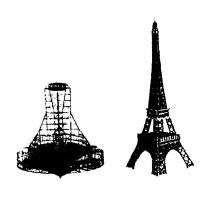
Figure 1: Owl and Eiffel Tower
The mechanical structure of the OverWhelmingly Large Telescope will allow it to have capabilities like no other ground-based system available. Its advanced cameras and spectrometers will allow the OWL to have a light gathering power reaching the 38th magnitude. The OWL will be able to collect astronomical information with 10 times the area of all existing professional telescopes combined. In addition to all of this, the adaptive optics of the OWL allow it to observe details as small as 1.4 millarcseconds which is equivalent to the width of a penny seen from 1,700 miles away. (Schilling) The technology needed in adaptive optics to account for this advancement is becoming available to astronomers through the U.S. Department of Defense. ("Strategy") Thus, the OWL is the most advanced ground-based telescope system under consideration.
4. X-ray Telescopes: The Chandra X-ray Telescope
Space-based x-ray technology is a relatively new concept; however, the Chandra X-ray Observatory has taken a major step towards the advancement in this astronomical field. The purpose of the Chandra will be to capture x-rays emittted from stars and other celestial bodies to identify various processes of the universe. (Wyatt) The Chandra will also be used to pinpoint targets for optical ground-based and space-based observation systems. (Elvis)

Figure 2: Chandra X-Ray Observatory
4.1 The Mechanical Structure of the Chandra
The Chandra X-ray Telescope is a large satellite at 13.8 meters (45 feet) long to create a large range of area for x-rays to reflect. The high-energy photons of a x-ray can only bounce off of a mirror if they hit the mirror parallel to its surface. They must hit at angles of incidence larger than a degree, or they will merely be absorbed. The Chandra consists of four sets of cylindrical mirrors each with a smooth surface area. The mirrors were made beginning with shells 2.5 centimeters thick allowing the cylindrical mirror shells to be perfectly round. Thus, this allowed the mirrors to be given the proper hyperboloidal and paraboloidal curves needed for sharp focus of the x-rays. The Chandra contains two cameras: the AXAF CCD Imaging Spectrometer and the High Resolution Camera (HRC). The AXAF CCD Imaging Spectrometer uses two types of charge-coupled devices (CCDs). The first CCD is especially sensitive to low energy x-rays; the other CCD is especially sensitive to higher energy x-rays, however, it still offers high resolution at all energy levels. The High Resolution Camera has the widest field of view and the highest angular resolution. The HRC incorporates microchannel plates which are special purpose detectors sensitive to Chandra’s entire spectral band and will record the arrival time to the nearest 16 microseconds of each x-ray necessary for the understanding of highly variable collapsed objects. (Elvis)
The Chandra X-ray Observatory will make several advancements for x-ray technology contributing to a deeper understanding of the universe. One of the most important advancements of the Chandra is its orbital length; the orbit of the Chandra will range from 10,000 km (about 6,000 miles) closest to earth and 140,000 km (about 86,400 miles) farthest from earth. (Wyatt) It will spend most of its time near or at 140,000 km allowing the Chandra to spend 80% of its time collecting data. (Elvis) It is said to be 20-50 times more sensitive than any previous x-ray telescope. (Anselmo) Due to the size of Chandra, it will have a larger field of view three times the focal length of any previous x-ray telescopes. Lastly, the Chandra will also be used to pinpoint target for optical investigation of space-based or ground-based telescopes. (Elvis)
5. Space-based Telescopes: The Next Generation Space Telescope (NGST)
The Next Generation Space Telescope will be a follow up space telescope for the Hubble. The NGST will go above and beyond any other space technology currently available. It will have advanced design along with improved instrumentation. However, the most important issue surrounding the NGST is its purpose to study the origins of the universe as no other technology before has attempted.
The NGST task group has established goals for the NGST design and accomplishments in orbit. The task group had originally established some general criteria regarding the initial design of the system. The task group stated that it wanted NASA to develop a space observatory on at least a four meter telescope using optimal imaging and spectroscopy. The NGST should also be able to operate at a diffraction limit over the wavelength range of one to five microns. These are now three companies competing for the overall design of the NGST. The NGST is expected to accomplish many goals in scientific research while in orbit. The two major goals surrounding the NGST are the following: to accomplish a detailed study of the birth and evolution of the galaxies throughout the universe and to detect any earth-like planets and the presence of the life on them. ("NGST Report") One focus of the NGST will be to look into the stars and galaxies to further understand how they formed during the big bang. ("NASA") The NGST will look into the shape of the universe and the life cycles of the universe. ("NGST Science") Scientists are not only interested in the beginning of the universe for the historical purpose, but also to gain understanding into quantum mechanics. Quantum mechanic’s is the supporting argument behind many scientific theories; the more facts scientists reveal about quantum mechanics, the more scientific theories will become facts. ("NGST Report") Thus, the NGST will have functions beyond any other astronomical observation unit ever created.
5.2 The Advantages of the NGST
The NGST has advantages over other space-based technology. The NGST will consist of various updated instrumentation. First, it has cryogenically cooled instruments allowing it to orbit beyond the moon. The NGST will carry the largest mirror ever to be flown on a space-based observatory, will consist of light weight materials costing less than the Hubble, and will show the possibility for improved infrared detection. Due to these improvements, the NGST is 1000 times more sensitive than other ground-based system created. ("NGST Visiting") All of these qualities will allow it to detect signals from the first billion light years thus the NGST will be able to accomplish its goals while in orbit.
6. The Critique of the Three Astronomical Observation Systems
Ground-based technology, x-ray technology, and space-based technology are very beneficial fields in astronomical observation and still continue to improve. However, the systems also have negative aspects to be considered. The new advancements in the field have already been presented. Now each of the three systems will be critiqued to show the most beneficial method of astronomical observation.
6.1 The OverWhelmingly Large Telescope
The OverWhelmingly Large Telescope is advanced for ground-based technology, however, there are still many problems with its design which make other systems more beneficial. Although the OWL will be designed to provide air-conditioning during the daytime temperatures, it still lacks cryogenically cooled optics needed for optimal results (NGST FAQ) Also, the earth’s atmospheric turbulence will cause a blurring effect in the pictures taken by the OWL. Another worry surrounding the OWL is the amount of computer power needed to operate the OWL; the OWL will need a half million computer-steered actuators to constantly align its 2,000 primary segments. This can be very costly and time consuming. In addition, the OWL has a high relative cost for ground-based technology, with an expected cost 900 million dollars. (Schilling) This is a large sum of money to be put into ground-based technology when space-based technology is more advanced and beneficial.
6.2 The Chandra X-ray Telescope
The Chandra X-ray Observatory has earned the field of x-ray observation astounding praise; however, x-ray technology has its share of downfalls. The first problem with x-ray technology is that it does not supply color or high resolution. Due to this, it is primarily used to locate targets for ground-based and space-based technology to further observe for more detail. Currently, the existing software used for interpreting the data results is based on the work from the 1970s. Thus, it is extremely hard for astronomers to interpret the data results they receive from the Chandra. Therefore, the Chandra is required to use a large team to spend the time figuring calculations and measurements to support the data from the Chandra. (Elvis) This can be a very consuming and costly process.
6.3 The Next Generation Space Telescope
The Next Generation Space Telescope, however, will be able to accomplish all that the OverWhelmingly Large Telescope can accomplish and better. The NGST has cryogenically cooled objects whereas the OWL is merely air conditioned to nighttime temperatures. The NGST will be in orbit past the moon thus will take clear pictures; the NGST will not have to worry about the earth’s atmospheric interference. The NGST contains high resolution imaging allowing it to be 1000 times more sensitive than any ground-based system. The NGST will have the power to locate its own targets thus the chandra will be unnecessary to the NGST. (NGST Visiting) The NGST will be capable of studying conventional astronomy while looking into the beginnings of the universe t investigate quantum mechanics. (NGST Report) For these reasons, the Next Generation Space Telescope shall prove to be the most beneficial form astronomical observation for the future.
7. Next Generation Space Telescope Designs
In general, the NGST will make key advances in a wide range of space technologies. They include large, lightweight, cryogenic mirrors, cryogenic actuators, and large format visible/IR detectors, among other technologies. Additionally, all designs will function similarly. They will be launched into space in 2008, and the mission lifetime is 10 years. Also all of the designs have identical wavelength coverage of 0.6 to 30 nanometers and identical camera field of views of 16 square meters. The design of the NGST starts with what type of orbit is chosen. ("Technology.")
The NGST will make a great deal of observation in the infrared portion of the spectrum. So thus, it is pertinent that the telescope be very frigid. Any extra heat would create an artificial background signal and cloud the already faint light from very distant astronomical sources. The two orbits that satisfy this are the "L2" and "1x3 AU" orbits. Both orbits are sufficient and there are only slight differences.
This orbit is an elliptical orbit about a design solved by the French mathematician Lagrange in the 18th century. In this solution, the space telescope would orbit around the "semi stable second Lagrangian point." L2 Orbit provides easier communication and also would be simpler to launch into. ("Proposed")
This possibility would be an orbit whose closest approach to the Sun is 1 Astronomical Unit and whose farthest point would be 3 Astronomical Units from the Sun. As an added benefit to already reaching the requirements would be that this orbit is beyond the zodiacal dust found in our solar system. ("Proposed")
This concept focuses on a large monolithic telescope. This telescope uses a six-meter diameter primary mirror. It is also the largest non-deployable telescope that can be launched into space. The Lockheed-Martin Design travels along the 1-3 AU elliptical heliocentric orbit in the ecliptic plane. ("Technology")
7.2.1 Goals of the Lockheed Martin Concept
The goal of the Lockheed-Martin design is to maximize sensitivity in the NIR while minimizing complexity. To achieve the minimum complexity, the design incorporates the Ritchey-Chretien two-mirror design. The secondary mirror in this design fits within the fairing and does not deploy. This eliminates any chances of failure in a deployment based space telescope. ("Technology")
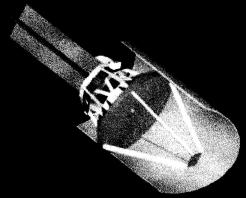
Figure 3: Lockheed Martin Design
7.2.2 Advantages and Disadvantages of the Lockheed Martin Concept
The Lockheed Design will be the simplest concept to fulfill requirements and also most cost efficient. However, it will not take advantage of all the possible technologies that could be added to make this space telescope even better. ("Technology")
7.3 TRW-Ball Aerospace Concept
This concept is a large deployable system, which TRW is very experienced with. The primary mirror that will be integrated into the system will be an 8 meter diameter mirror and it consist of six hexagonal petals that deploy after launch. The secondary mirror will also be folded and then deploy when the space system has been launched. This concept will travel around the L2 orbit. ("Technology")
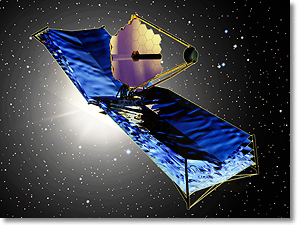
Figure 4: TRW/Ball Design
7.3.1 Goals of the TRW-Ball Aerospace Concept
The goal of the TRW-Ball Aerospace design is to take advantage of maximum system function. For example, this design, in addition to having a shield geometry that balances the radiation pressure torque from sunlight, will also offer variable reflectivity. "Electrochromic" patches on the sunshield can also yield solar torques to unload the attitude control system momentum wheels. ("Technology")
7.3.2 Advantages and Disadvantages of the TRW-Ball Aerospace Concept
The TRW-Ball Aerospace design will be the most advanced of the three candidate designs. It will offer functions like variable reflectivity that the other two telescopes cannot. However, the costs of this telescope will also be greater than the other two. ("Technology")
This design is similar to the TRW-Ball Aerospace Concept. It will use deployable, lightweight mirrors that will fit within the launch vehicle. However, rather than using separate systems like the TRW-Ball Aerospace design, GSFC will have a single bipropellant system for orbit transfer, station keeping, and offsetting radiation torque buildup. This design also calls for an 8-meter diameter primary mirror and it will move according to the L2 orbit. ("Technology")
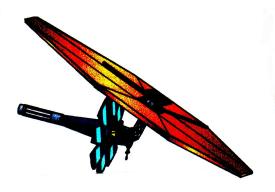
Figure 5: GSFC Design
The goal of the GSFC design is to reduce financial and technical risks and to favor simple solutions that use promising technologies without launching large research programs. Thus it combines the many separate systems that the TRW-Ball Aerospace design calls for into one system. ("Technology")
7.4.2 Advantages and Disadvantages of the GSFC Concept
The relative simplicity of the GSFC design cuts down on the risks and still meets the minimum requirements of the space telescope. However, the trade-off is that its function capability will not be as superior as the others. Also, while the odds of malfunction decreases, the magnitude of a malfunction will be much greater everything is integrated into one single system. ("Technology")
8. Next Generation Space Telescope Instrumentation
The instruments included on the NGST will be integral to the performance of its mission. Most of the optical devices will be improved versions of those included on the Hubble Space Telescope. The scientific instruments on the NGST will likely include cameras and spectrometers.
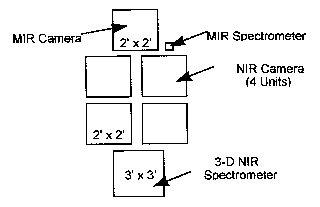
Figure 6: System Array
To best achieve the optical standards required by the NGST’s mission, traditional camera devices will be employed to operate in the spectrum ranging from the near-infrared visible spectrum to the mid- infrared range, covering an area from .5 to 30 microns. The most efficient method of achieving this spectrum is to employ two separate cameras, one for each range. ("Yardstick")
The camera design goals for the NGST are threefold: first, a high performance large field of view optical design. This will allow the NGST to take full advantage of its power and location in space to observe distant celestial objects. Second, low noise detecting devices are desirable. Noise refers to interference within the device itself, or distortions in the images due to equipment limitations. Low noise detectors allow the highest definition for photography. Finally, low temperature operation is key. Not only must the devices be able to operate in the extreme cold of space, but also to maximize the efficiency of the detecting elements. ("Yardstick")
The camera operating in the near-infrared range would be a wide field of view device. It will take advantage of the highest spatial resolution available from the NGST’s mirrors. The two most likely detectors for the collecting plates are indium antimony (InSb) and mercury cadmium tellurium (HgCdTe). Both have proven suitable for this type of use. InSb must be used at temperatures of about 35 K, while HgCdTe can operate up 3 microns in the 70 K range. However, HgCdTe has much more significant dark current interference. ("Technology")
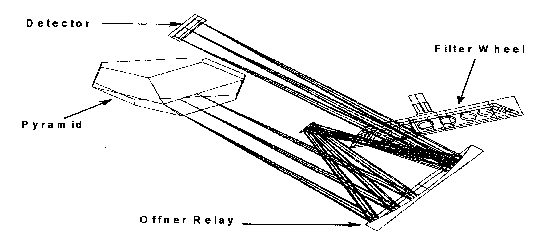
Figure 7: NIR Camera
The other camera would operate in the remaining infrared range, from 5 to 30 microns. It will likely use Silicon: Arsenic detectors, which have been successfully utilized in previous instruments. One of the improvements likely to be included is a refractive optics system, rather than a reflective one, as shown in Figure 8. This system uses a series of concave mirrors, conserving valuable space in the instrument array, and making it easier to produce than a traditional system. This camera will be vital to detecting infrared signals from the genesis of the first galaxies. ("Yardstick")
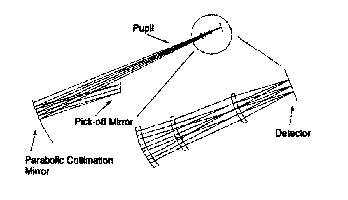
Figure 8: MIR Camera
Spectrographs will be the second type of instrument included on the NGST. These light-collecting devices will be used to observe celestial phenomena not within the reach of traditional optical systems. Again, the spectrograph should cover wavelengths from .5 to 30 microns. There will likely be two spectrographs, in the mid- and near-infrared ranges, but both will not likely be separate from the cameras. ("Yardstick")
8.2.1 Spectrograph Design Goals
The spectrographs are desired to operate in both a high resolution and wide field of view mode. Also, they must be designed for maximum efficiency, as they will likely be a secondary device to the cameras, and will not be as relatively technologically advanced as the cameras. ("Yardstick") Also, one or more of the following types of sampling will be employed: Integral Field, Multi-Object, and Fourier Transfer. ("NIR Spectrograph")
8.2.2 Near Infrared Spectrograph
The near-infrared spectrograph will likely be a wide field of view, multi-object device; this means that it will be employed to observe multiple targets over a broad angular area. To accomplish this, advanced micromirror arrays will be employed, as in Figure 9. This design will allow the mirrors to be arranged in any desired configuration. This integrated cicuit design will be an improvement over traditional silicon CCD’s, although not an inexpensive one. ("NIR Spectrograph") Also, this device shows versatility with the ability to perform target acquisition in a special camera mode, using a filter rather than the traditional grisms. This will help the NGST to be a self-sufficient system, not having to rely on other instruments for targeting. ("Yardstick")
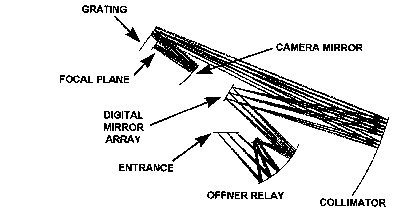
Figure 9: NIR Spec
8.2.3 Mid-Infrared Spectrograph
Integrated into its cousin, the MIR camera, will be the mid-infrared spectrometer. It will be a single aperture device with a high spatial and spectral resolution. ("NIR Spectrograph") In order to conserve the limited space within the instrument array, it will likely share the same Si:As detectors as the MIR camera. However, this has the disadvantage of not allowing the two devices to work simultaneously. The range of this device will be divided into two, from 5.8 to 13.1 and from 12.75 to 21.2 microns, with a cross-dispersing implement used on the former band. This device will be extremely economical; it could share nearly all of its components with the MIR camera. ("Yardstick")
9. Next Generation Space Telescope Lightweight Optics
One of the key technologies being developed for the NGST is lightweight optics. Specifically, the mirrors being used for the NGST are being specially developed to be as light as possible. By making the mirrors, which are usually exceptionally massive, lighter, the NGST becomes much more economical. With a finite amount of capital available for the project, lightweight materials take on the utmost importance.
9.1 Light Weight Optics Requirements
The mirrors for the NGST have a few requirements. First of all, the mirror must have a collecting area of 25 to 40 m². The mirror must have a mass of less than 15 kg for every m² of collecting area. Also, the mirror must be able to function and temperatures as low as 40 K. ("The University of Arizona")
There are currently four mirror designs in development. The University of Arizona is developing a glass membrane mirror, Composite Optics, Inc (COI). is working on a zerodur mirror, the Marshall Space Flight Center (MSFC) is developing a nickel alloy mirror, and, finally, Ultramet is working on a silicon carbide (SiC) mirror. ("Next Generation Space Telescope")
The University of Arizona mirror is the furthest along in its developmental stage. The university actually has a prototype that could work in the NGST. The prototype consists of a 2-mm thick, circular glass membrane. The membrane has a diameter of 6.5 m. Many paper-thin carbon sheets support the structure. These sheets offer rigid support for short periods of time (days to months) while weighing less than 5 kg/m².
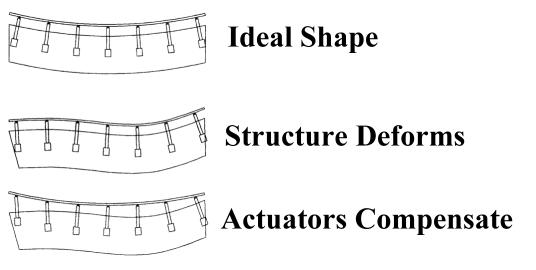
Figure 10: Actuator Progression Demonstration
The system also consists of position actuators that help the mirror retain its shape. Over time the carbon structure starts to deform, taking the membrane with it. The actuators push up in certain places to compensate for any deformities. The prototype has about 50 actuators per m².

Figure 11: Glass Membrane Mirror
The membrane itself has a very low coefficient of thermal expansion (CTE), which means that its structure does not change much with extreme temperatures. It also has high CTE uniformity, which means that the small amount of structural change will be uniform throughout the membrane. This minimizes the amount of work required from the actuators. ("The University of Arizona")
Zerodur is a type of reinforced glass. Composite Optics, Inc. is building their mirror with an optical surface of low CTE glass. The rest of the mirror consists of a low-density, low CTE carbon fiber composite. This composite offers high stiffness without adding much mass to the system. The carbon composites manufactured by COI have a mass 30 – 80% less than aluminum. ("Welcome to Composite")
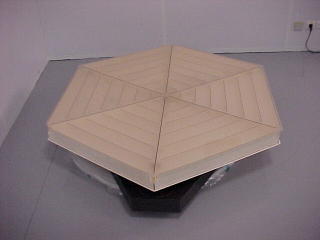
Figure 12: Zerodur Mirror
The approach that COI is taking towards the cryogenic temperature restriction is all in materials. COI has selected materials that behave very well at cryogenic temperatures. Cryogenic temperatures actually increase the performance of these materials by augmenting material property uniformity. (Kasl)
The Marshall Space Flight Center is taking a different approach to developing a mirror. The MSFC’s mirror is made up entirely of nickel alloy, produced by a process called electroforming. Mirrors made by this process are much stronger than glass mirrors, and less likely to fracture. These mirrors are also more economical than conventional glass or ceramic because they do not have to be ground or polished. Electroforming produces an incredibly smooth surface. The mirrors are extremely light. Electroformed nickel is about 10 times lighter than conventional nickel.
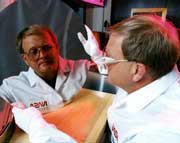
Figure 13: Nickel Alloy Mirror
Researchers are studying the possibilities of electrojoining and other bonding techniques to help prepare the mirrors for cryogenic temperatures. The most prominent problem is uneven thermal expansion. Bonding the mirror surface to a support structure may help prevent this. ("NASA’s Marshall")
Ultramet’s silicon carbide (SiC) mirror is another unique design. It consists of a smooth, polished, SiC surface, supported by a layer of SiC foam. The SiC foam supports the structure while having very low density. The polished surface has optical properties exceeding those of glass, metal, and ceramic.
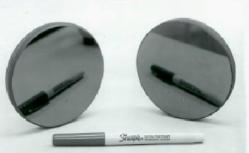
Figure 14: Silicon Carbide Mirrors
The silicon carbide mirrors have not yet been tested at cryogenic temperatures. However, they have been completely submerged in liquid nitrogen (about 77 K) without any structural change. The mirrors also retain their shape when only half of the mirror is submerged, creating a thermal gradient greater than 150 K across the mirror faceplate. These findings indicate that the mirror will also retain its shape at cryogenic temperatures, although there is no certainty until it is tested. ("Welcome to Ultramet")
10. Conclusions and Recommendations
The Next Generation Space Telescope should be pursued as the best option for astronomical observation. We recommend that the NGST be designed as follows. The TRW-Ball Aerospace satellite design should be utilized, due to its maximum performance delivered from among the candidate designs. Although the cost may be somewhat higher than the other candidates, the improved performance offered by this design will allow the NGST to best advance the field of astronomical observation. Also, this design utilizes the L2 orbit, which provides better communications capability, and allows a greater payload to be orbited. The NGST would best be served by an instrument array featuring two cameras, with the NIR camera utilizing InSb detectors, and the MIR camera featuring Si:As detectors, as well as a separate NIR spectrograph, and an integrated MIR spectrograph. This array would most efficiently perform the objectives of the NGST. The mirrors for the NGST should be the Nickel Alloy construction, because of its superior strength to glass or silicon carbide, and its simple design, which will reduce the possibility of systems complications. With this design format, the NGST will be an instrumental tool for astronomical observation, to help advance scientific inquiry in the twenty-first century.
Works Cited
Anselmo, Joseph C. “Chandra’s Successors in the Works.” Aviation Week & Space Technology. August 2, 1999.
Elvis, Martin. “NASA’s Chandra X-Ray Observatory: A Revolution Through Resolution.” Sky and Telescope. August, 1999.
Kasl, Eldon <REMOVED>. “Answers to NGST Questions.” December 6, 1999. Graham Fiorani <REMOVED>.
“NASA Reveals Next Generation Telescope Plans.” [Online] Available http://www.exosci.com/news/69.html. Decembe 1, 1999.
“NASA’s Marshall Space Flight Center.” [Online] Available http://www.msfc.nasa.gov/. November 28, 1999.
“Next Generation Space Telescope.” [Online] Available http://www.ngst.nasa.gov/. December 9, 1999.
“NGST: Report of the NGST Task Group.” [Online] Available http://astro.estec.esa.nl/NGST/NTGrep.pdf. December 1, 1999.
“NIR Spectrograph Study.” [Online] Available http://www.ngst.stsci.edu/nir_spec_study99/nir_summary.html. December 2, 1999.
“Proposed NGST Orbits.” [Online] Available http://ngst.gsfc.nasa.gov/project/text/orbits.html. December 10, 1999.
Shilling, Govert. “Giant Eyes in the Sky.” Astronomy. December 1999.
“A Strategy for Ground-Based Optical and Infrared Astronomy: III. Opportunities in OIR Astronomy.” [Online] Available http://www.nap.edu/readingroom/books/gboi/chap3.html. December 3, 1999.
“Technology for the Next Generation Space Telescope.” [Online] Available http://oposite.stsci.edu/ngst/intitial-study/NGST-FullProposal.pdf. December 2, 1999.
“The University of Arizona.” [Online] Available http://www.arizona.edu/. November 15, 1999.
“Welcome to Composite Optics, Inc. on the Internet.” [Online] Available http://www.coi-world.com/. December 10, 1999.
“Welcome to Ultramet.” [Online] Available http://www.ultramet.com/. December 8, 1999.
Wyatt, Rebecca. “NASA’s New Observatory.” Insight on the News. October 4, 1999.
“ ‘Yardstick’ Integrated Science Instrument Module Concept for NGST.” [Online] Available http://ngst.gsfc.nasa.gov/Hardware. December 2, 1999.
Counter provided by http://www.digits.com